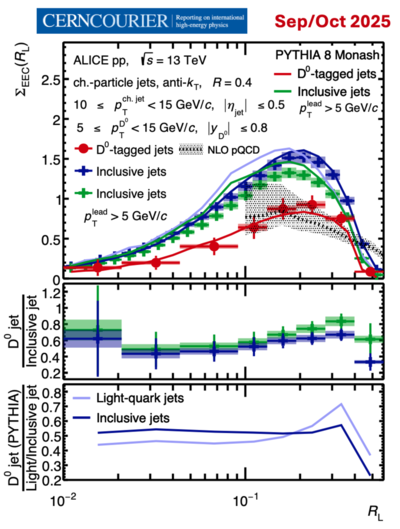
Article in CERN Courier Sep/Oct 2025
Narrow sprays of particles called jets erupt from high-energy quarks and gluons. The ALICE collaboration has now measured so-called energy–energy correlators (EECs) of charm-quark jets for the first time – revealing new details of the elusive “dead cone” effect.
Unlike in quantum electrodynamics, the quantum chromodynamics (QCD) coupling constant gets weaker at higher energies – a feature known as asymptotic freedom. This allows high-energy partons to scatter and radiate additional partons, forming showers. As their energy splits between more and more products, decreasing toward the characteristic QCD confinement scale, interactions grow strong enough to bind partons within colour-neutral hadrons. The structure, energy profile and angular distribution of particles within the jets bear traces of the initial collision and the parton-to-hadron transitions, making them powerful probes of both perturbative and non-perturbative QCD effects. To understand the interplay between these two regimes, researchers track how jet properties vary with the mass and colour of the initiating partons.
Due to the gluon’s larger colour charge, QCD predicts gluon-initiated jets to be broader and contain more low-momentum particles than those from quarks. Additionally, the significant mass of heavy quarks should suppress collinear gluon emission, inducing the so-called “dead-cone” effect at small angles. These expectations can be tested by comparing jet substructure across flavours. A key observable for this purpose is the EEC, which measures how energy is distributed within a jet as a function of the angular separation RL between particle pairs. The large-RL region is dominated by early partonic splittings, reflecting perturbative dynamics, while a small RL value corresponds to later radiation shaped by final-state hadrons. The intermediate-RL region captures the transition where hadronisation begins to affect the jet structure. This characteristic shape enables the separation of perturbative and non-perturbative regimes, revealing flavour-dependent dynamics of jet formation and hadronisation.
The ALICE Collaboration measured the EEC for charm–quark jets tagged with D0 mesons, reconstructed via the D0 → K– π+ decay mode (branching ratio 3.93 ± 0.04%), in proton–proton collisions at centre-of-mass energy 13 TeV. Jets are inferred from charged-particle tracks using the anti-kT algorithm, clustering products in momentum space with a resolution parameter R = 0.4.

Fig. 1 Energy–energy correlators (EEC) of D⁰-tagged jets compared to inclusive jets, shown with (green) and without (blue) a leading-track pₜ selection of 5 GeV/c. Data are compared to next-to-leading-order (NLO) pQCD calculations (dashed) and PYTHIA 8 simulations. The middle panel shows the data ratio of D⁰-tagged to inclusive jets. The bottom panel displays the same ratio in PYTHIA 8, also including light-quark jets.
At low transverse momentum, where the effect of the charm-quark mass is most prominent, the EEC amplitude is found to be significantly suppressed for charm jets relative to inclusive jets initiated by light-quarks and gluons. The difference is more pronounced at small angles due to the dead-cone effect (see figure 1). Despite the sizable charm–quark mass, the distribution peak position remains similar across the two populations, pointing to a complex mix of parton flavour effects in the shower evolution and enhanced non-perturbative contributions such as hadronisation. Perturbative QCD calculations reproduce the general shape at large RL but show tension near the peak, indicating the need for theoretical improvements for heavy-quark jets. The upward trend in the ratio of charm to inclusive jets as a function of RL, reproduced with PYTHIA 8, suggests that they deviate in fragmentation.
This first measurement of the heavy-flavour jet EEC helps disentangle perturbative and non-perturbative QCD effects in jet formation, constraining theoretical models. Furthermore, it provides an essential vacuum baseline for future studies in heavy-ion collisions, where the quark–gluon plasma is expected to alter jet properties.
Further reading:
ALICE Collab. 2025 arXiv:2504.03431.
